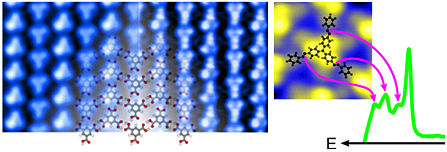
टी. जी. गोपकुमार
PhD (University of Chemnitz)
Professor, Department of Chemistry
SL 213 ,
Department of Chemistry
IIT Kanpur,
Kanpur 208016
विशेषज्ञता
Molecular Functional Materials
Scanning Tunneling and Atomic Force Microscopy
Surface Science
शिक्षा
PhD (2006), Technical University of Chemnitz Germany
M. Sc. (2001) Mahatma Gandhi University
शिक्षण क्षेत्र
Surface science
Solid state and condensed matter
Near field microscopy
Vacuum techniques
चयनित प्रकाशन
Low Threshold Reversible Electron Induced and Selective Photo Induced Switching of Azobenzene Derivatives at Ambient Conditions, J. Phys. Chem. Lett., 9, 6326 (2018)
Selection of Adlayer Patterns of 1,3-Dithia Derivatives of Ferrocene by the Nature of Solvent, J. Phys. Chem. C, 122, 19067 (2018)
Remotely triggered geometrical isomerization of a binuclear complex,
J. Am. Chem. Soc., 136, 6163 (2014)
Broken symmetry of an adsorbed molecule revealed by scanning tunneling spectroscopy,
Angew. Chem. Int. Ed. 52, 11007 (2013).
Surface Control of Alkyl Chain Conformations and 2D Chiral Amplification,
J. Am. Chem. Soc. 135, 8814 (2013).
Electron-Induced Spin Crossover of Single Molecules in a Bilayer on Gold,
Angew. Chem. Int. Ed. 51, 6262 (2012).
Transfer of Cl ligands between adsorbed Fe-Tetraphenylporphyrin molecules,
J. Am. Chem. Soc. 134, 11844 (2012).
Polymorphism Driven by Concentration at the Liquid-Solid Interface,
J. Phys. Chem. C, 115, 21743 (2011).
Influence of Solvophobic Effects on Self-Assembly of Trimesic Acid at the Liquid−Solid Interface,
J. Phys. Chem. C, 114, 3531 (2010).
HOMO-LUMO Gap Shrinking Reveals Tip-Induced Polarization of Molecules in Ultrathin Layers: Tip-Sample Distance-Dependent Scanning Tunneling Spectroscopy on d8 (Ni, Pd, and Pt) Phthalocyanines,
J. Phys. Chem. C 112, 2529 (2008).
Adsorption of Palladium Phthalocyanine on Graphite: STM and LEED Study,
J. Phys. Chem. B. 108, 7839 (2004)
पेशेवर अनुभव
Associate Professor, IIT Kanpur, 2018
Assistant Professor, IIT Kanpur, 2013-2018
Postdoctoral Fellow, Christian-Albrecht University of Kiel, 2008-2013
Postdoctoral Fellow, Chemnitz University of Technology, 2006-2008
National Chemical Laboratory Pune, 2002
वर्तमान शोध
Structure and electronic properties of molecules at interface of metal or semiconductor are of great importance in molecular semiconductor industry. The interest on molecular materials is fuelled due to its small size, highly tunable magnetic and electronic properties and plenty of choice. In addition they offer the unique self-assembling property through which one may design any complex structure, even a most complicated design as in animate systems.
Some molecules imitate electronic functionalities like switches, diodes, rectifiers and wires. These molecules -generally called - functional molecules are candidates for future electronic devices based on single molecules. In addition to technological applications the molecules at interface are also of fundamental importance. They do behave different to their bulk counterpart. For example a square planar Fe-porphyrine behave like a square pyramidal structure on Au(111) surface, for which the 5th ligand is the surface itself.
We are investigating molecules on surface, especially functional molecules, using Scanning Tunnelling Microscope (STM) working at solid-liquid interface at ambient condition. STM working at solid-liquid interface offers a real time investigation of structure, dynamics etc. of molecules at interface. Self assembled monolayer of trimesic (TMA) acid is shown in the figure. TMA is a model system that self-assembles on different surfaces. Its self-assembly may be controlled by the nature of the solvent, concentration etc. The figure shows a high density structure of TMA (monolayer) controlled by concentration.

Tunneling spectroscopy is particularly interesting to understand the molecular electronic structure. A multifunctional molecular switch based on azobenzene on Au(111) surface is shown above. Modification of the molecular symmetry upon adsorption is directly reflected in tunneling spectrum.



